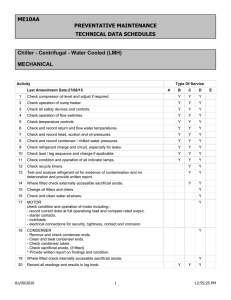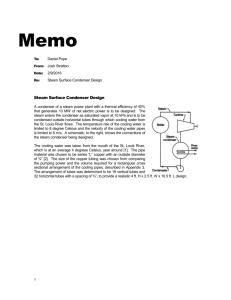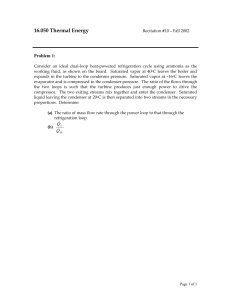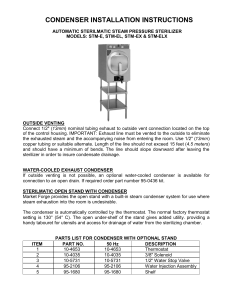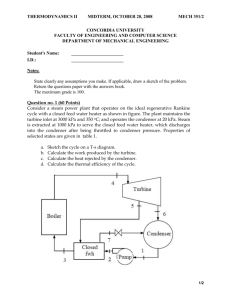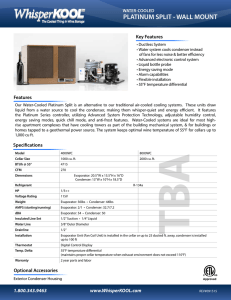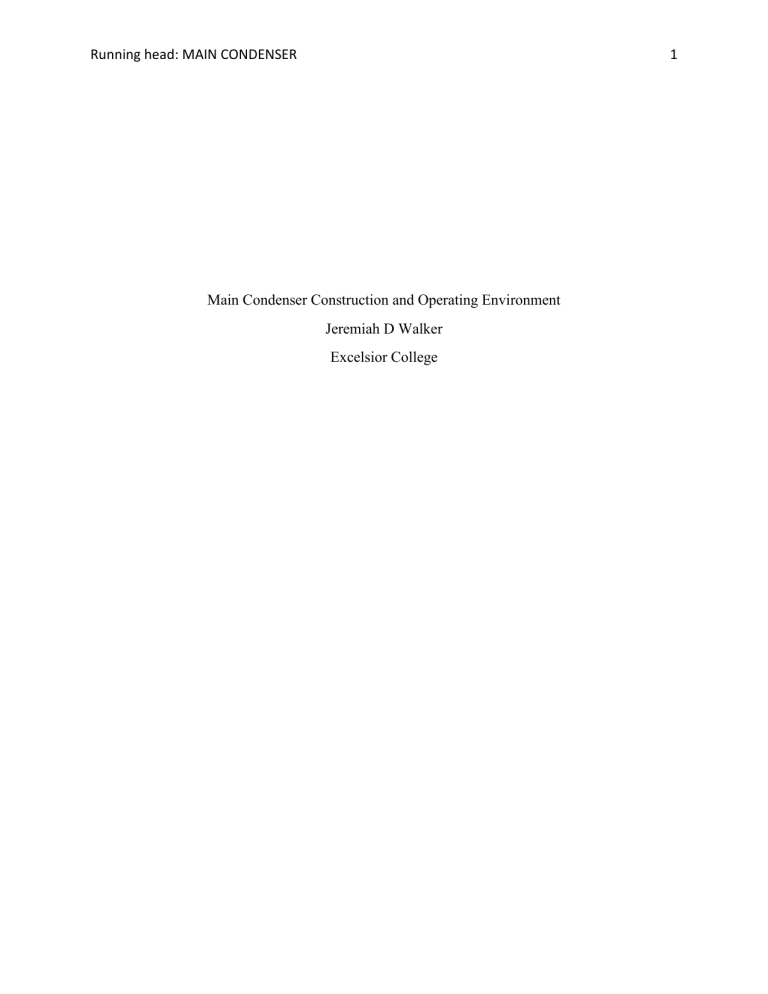
Running head: MAIN CONDENSER 1 Main Condenser Construction and Operating Environment Jeremiah D Walker Excelsior College MAIN CONDENSER 2 Abstract Main Condensers are a major interface portion between the steam and condensate systems and are subjected to a wide range of temperatures and pressures based on their operating conditions and the conditions of the cooling water running through the tubes. The condenser needs to be built of a sturdy and strong material such as a nickel copper alloy. The tubes need to be able to allow a large rate of heat transfer through a thin layer of material, which both could be accomplished by using titanium. Using different materials means that precautions need to be taken to ensure the extended life of the condenser by performing preventative maintenance and using corrosion preventative measures. MAIN CONDENSER 3 Main condensers are the interface between the steam system and the condensate system, and as such they need to be able to withstand large pressure and temperature transients while still maintaining their ability to transfer heat effectively. The condensers can be subjected to fresh water or seawater, which can affect the corrosion rate of the condenser tubes. These factors need to be mitigated by selecting materials that not only have a high corrosion resistance, but that also maintain their strength at extreme temperatures and pressures. By utilizing a nickel copper alloy for the construction of the condenser shell and titanium for the condensing tubes, we can have the best material for both needs of the system; high strength for the shell and high heat transfer ability and strength for the tubes. Using different materials for construction means that we need to ensure that corrosion prevention measures are taken, and that preventative maintenance is performed to ensure the long life of the condenser. The main condenser is the interface between the exhaust steam and the condensing water, and as such it is required to have both the strength to handle large temperature changes and resist corrosion from the medium being used as a heat sink. This requires the condenser tubes to be made of material that is strong in order to resist incoming steam temperature and pressure. Having the condenser tubes be made of titanium would ensure that the tubes could be made of a thin enough size for heat exchange to occur and be strong enough to resist incoming forces upon it. Titanium is expensive, and having the entire condenser made of titanium would both drive up the cost and increase the weight dramatically of the condenser (Nuclear Power, n.d.). By only building the tubes of the condenser out of titanium, we can both increase the heat transfer capability by being able to use thinner tubes, as well as maintain the overall cost of the condenser lower than building the entire condenser out of titanium. MAIN CONDENSER 4 We can have the shell made of a cheaper material such as a nickel copper alloy in order to mitigate the price of the condenser while still maintaining its structural integrity. Using nickel copper alloys will allow the condenser shell to still maintain its overall strength, because nickel copper is a strong material for construction, and since it will not be subject to the constant thermal stresses of the condenser tubes, it doesn’t need to have the same strength and resilience that the tubes need. The condenser will be made of two different materials, which makes it an ideal candidate for galvanic corrosion. Galvanic corrosion occurs when two dissimilar metals contact an electrolytic solution. This corrosion can be mitigated by using sacrificial anodes, such as zinc. The sacrificial anode would wear away by providing electrons for use by the different materials inside the condenser instead of the nickel copper alloy and prevent damage to the condenser. The condenser is also susceptible to chloride stress corrosion cracking as well as general corrosion, which requires materials resistant to corrosion. General corrosion can cause multiple cascading problems for the systems of the plant and the condenser is susceptible because it is filled with water and has the potential for oxygen inside, either during shutdown, or if the water being used is not de-oxygenated properly. These requirements are important because if the condenser were to corrode and cause a secondary tube leak from the heat sink into the steam system, it can cause chemistry concerns and chloride contamination in the steam system. To preserve the integrity of the condenser and the steam system, preventative maintenance needs to be performed on both the heat sink side and the steam system side of the condenser. Steam side maintenance should include inspections inside the condenser to determine the condition of the heat exchanger tubes and ensure that there is no indication of erosion from the steam. To mitigate erosion, we can install baffles or baffle tubes that do not have water MAIN CONDENSER 5 running through them, but are put in place to absorb some of the kinetic energy of the steam as it moves from turbine exhaust into the condenser. This will reduce the amount of energy imparted on the condensing tubes and allow for slower steam to have adequate heat transfer without damaging the tubes. The water side needs to be inspected for tube deficiencies such as tube blockages or build up inside the tubes that would inhibit heat transfer and flow. This is done by Eddy Currant Testing, which uses an electrical signal to detect wall thickness of the tubes and ensure there is not a problem with scale build up. We also need to perform borescope inspections to determine if tubes need to be cleaned by physical means. One way that condenser tubes can be cleaned is by brushing, where a hard-bristled brush is pushed through the tubes which will remove any soft scale buildup and push it out the opposite side to be collected. Performing hydro lancing is a method of removing hard caked on scale by using highly pressurized water to power wash the inside of the condenser tubes. This method requires extensive safety measures based on the pressure of the water being used. The water side also needs to have a visual inspection performed and sacrificial anodes replaced when they are corroded beyond minimum acceptable value. Condensers can also employ a double-tube sheet concept to provide an early warning system of sorts for tube leakage. In conclusion we can see that choosing the proper materials for condenser construction includes more than just selecting based on strength. Materials need to be selected based on corrosion resistance, heat transfer ability, and cost. Once materials are selected, the condenser cannot be expected to fulfill its purpose on its own without proper maintenance and inspections. These inspections can determine failed components, or materials in need of replacement such as MAIN CONDENSER sacrificial anodes. Preventative maintenance and corrective actions need to be implemented and maintained if the condenser is going to perform its function for the designed life of the plant. 6 MAIN CONDENSER 7 References Gonyeau, J. (2001). Condenser. Retrieved from http://www.nucleartourist.com/systems/cr.htm Nuclear Power. (n.d.) Main Condenser-Steam Condenser. Retrieved from https://www.nuclearpower.net/nuclear-power-plant/turbine-generator-power-conversion-system/maincondenser-steam-condenser/ U.S. DOE. (1993). DOE Fundamentals Handbook: Chemisty Vol 1 of 2. Retrieved from https://www.standards.doe.gov/standards-documents/1000/1015-bhdbk-1993v1/@@images/file U.S. DOE. (1993). DOE Fundamentals Handbook: Materials Vol 1 of 2. Retrieved from https://www.standards.doe.gov/standards-documents/1000/1017-BHdbk-1993v1/@@images/file U.S. DOE. (1993). DOE Fundamentals Handbook: Materials Vol 2 of @. Retrieved from https://www.standards.doe.gov/standards-documents/1000/1017-BHdbk-1993V2/@@images/file World Nuclear Association. (2019). Cooling Power Plants. Retrieved from http://www.worldnuclear.org/information-library/current-and-future-generation/cooling-power-plants.aspx
